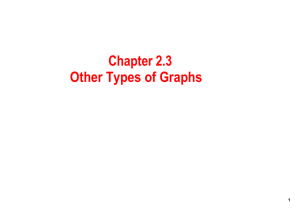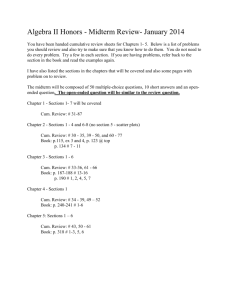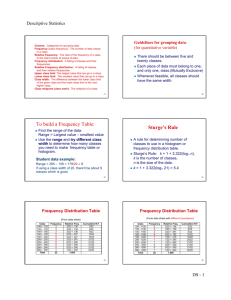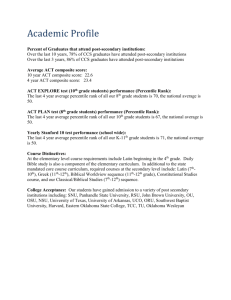E.D.A.
advertisement
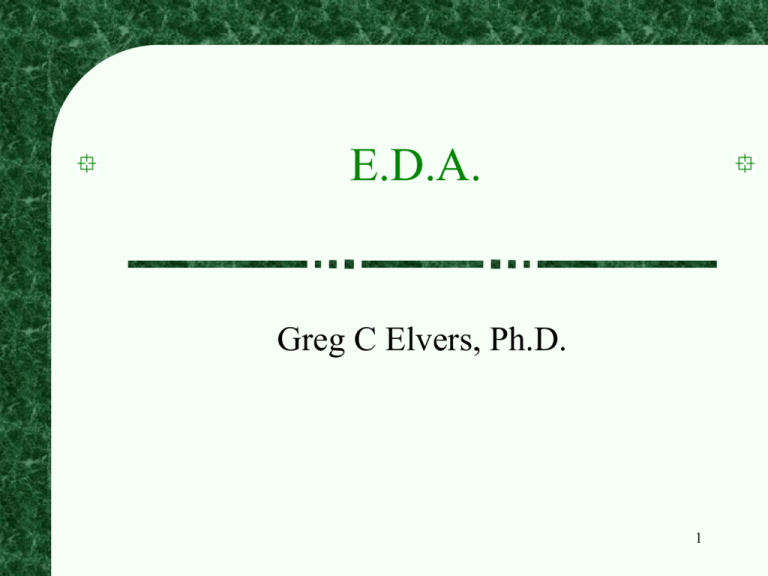
E.D.A. Greg C Elvers, Ph.D. 1 Exploratory Data Analysis One of the most important steps in analyzing data is to look at the raw data This allows you to: find observations that may be incorrect quickly tell if the data are “reasonable” (i.e., if they conform to expectations) see trends in the data The process of looking at the data is often called exploratory data analysis (E.D.A.) 2 E.D.A. Usually, the data set is so large that just looking at the data is meaningless The data need to be organized and summarized before you can interpret them Exploratory data analysis does just that 3 Steps for E.D.A. The first step in most exploratory data analysis procedures is to organize the data by sorting it The sorted data is then presented graphically in one (or more) of several manners: Stem and leaf plots Frequency distributions Tukey box plots 4 Stem and Leaf Plots Each quantitative Obs. Stem Leaf observation is broken 14 1 4 into two parts: the 132 13 2 stem and the leaf 2 * 41 The stem are all the 41.2 4 1 digits of the number except for the least 4 * 123 1234 significant digit 12 3 The leaf is the least *Depending on the range of numbers significant digit in the distribution, either stem and leaf could be used 5 Stem and Leaf Plots For each observation, determine its stem and its leaf Sort the stems, removing any duplicates List the leaves, one by one, to the right of its stem 59 57 75 90 100 95 74 84 84 91 73 88 78 69 64 74 53 86 64 72 Stem | Leaf 5 | 379 6 | 449 7 | 234458 8 | 4468 9 | 015 10 | 0 6 Create a Stem and Leaf Plot Create a stem and leaf plot from the following IQs: 82 80 97 111 121 116 96 105 105 112 95 109 100 92 86 96 76 108 87 94 104 88 120 91 85 7 Frequency Distributions A frequency distribution is a table that lists how often each number (or range of numbers) in the data occurs 82 80 97 111 121 116 96 105 105 112 95 109 100 92 86 96 76 108 87 94 104 88 120 91 85 Class Frequency 70-79 1 80-89 6 90-99 7 100-109 6 110-119 3 120-129 2 8 Frequency Distributions The class is a range of numbers that represent a category All members of the category have the same characteristics Frequency distributions allow you to quickly look at a large set of data to determine the general characteristics of the data 9 Cumulative Frequency Distributions The cumulative frequency distribution is derived from the frequency distribution by listing the number of scores that are less than or equal to the class. The cumulative frequency distribution is useful for calculating the percentile rank Class Freq. C. Freq. 70-79 1 1 80-89 6 7 90-99 7 14 100-109 6 20 110-119 3 23 120-129 2 25 10 Percentile Rank The percentile rank is the percentage of observations that are at or below a given score In the previous example, what percent of scores are less than or equal to your IQ (116)? To calculate the percentile rank, first create the cumulative frequency distribution Then, apply the formula given on the next 11 slide Percentile Rank Xi - Xll cum fll + fi w X 100 PR = N cum fll = cumulative frequency of the class below X Xi = score to be converted to percentile rank Xll = score at the lower real limit of the class containing X w = width of the class fi = number of cases within the class containing x 12 N = number of scores in the distribution Cumulative Frequencyll, Xi E.g., the cumulative frequency of the class below 116 is 20 cum fll = 20 The score to be converted, Xi is 116 in this example Class Freq. C. Freq. 70-79 1 1 80-89 6 7 90-99 7 14 100-109 6 20 110-119 3 23 120-129 2 25 13 Lower Real Limit Because the classes are continuous, we need to find the true limit of the class The unit of measure is one, so the lower real limit of the class containing Xi is: 110 - (1 / 2) = 109.5 Class Freq. C. Freq. 70-79 1 1 80-89 6 7 90-99 7 14 100-109 6 20 110-119 3 23 120-129 2 25 14 Width, Frequency, and N The width of the class is 10 (the difference of the true limits, e.g. 79.5 - 69.5 = 10) The number of observations within the class containing Xi is 3 = fi N, the number of scores is 25 Class Freq. C. Freq. 70-79 1 1 80-89 6 7 90-99 7 14 100-109 6 20 110-119 3 23 120-129 2 25 15 Calculating the Percentile Rank 116 - 109.5 Xi - Xll 20 + X3 cum fll + X fi 10 w PR = X 100 = X 100 = 87.8 N 25 cum fll = 20 Xi = 116 Xll = 109.5 fi = 3 w = 10 N = 25 16 Score Corresponding to a Percentile Rank (PR) Create the cumulative frequency distribution Use the following formula where cum fPR = cumulative frequency (percentile rank X number of observations / 100) cum fll = cumulative frequency of the class below the class cum fPR containing PR Xll = score at lower real limit of class containing PR w = width of class fi = number of cases within the class containing PR XPR w cum fPR - cum fll = Xll + fi 17 What Score Corresponds to a Percentile Rank of 87.8? cum fPR = the percentile rank times the number of scores divided by 100 87.8 X 25 / 100 = 21.95 Class Freq. C. Freq. 70-79 1 1 80-89 6 7 90-99 7 14 100-109 6 20 110-119 3 23 120-129 2 25 18 Cumulative Frequencyll Convert the cumulative frequencies to percentages (divide each by the number of observations, e.g. 25) Class Freq. C. Freq. % C. Freq 70-79 1 1 0-4 80-89 6 7 5 - 28 90-99 7 14 29 - 56 100-109 6 20 57 - 80 110-119 3 23 81 - 92 120-129 2 25 93 - 100 19 Cumulative Frequencyll The cumulative frequency below the class containing 87.8% of the scores is 20 cum fll = 20 Class Freq. C. Freq. % C. Freq 70-79 1 1 0-4 80-89 6 7 5 - 28 90-99 7 14 29 - 56 100-109 6 20 57 - 80 110-119 3 23 81 - 92 120-129 2 25 93 - 100 20 Lower Real Limit and Width The lower true limit of the class containing 87.8 is: 110 - (1 / 2) = 109.5 Xll = 109.5 The width of the class is 10 (see previous width) Class Freq. C. Freq. % C. Freq 70-79 1 1 0-4 80-89 6 7 5 - 28 90-99 7 14 29 - 56 100-109 6 20 57 - 80 110-119 3 23 81 - 92 120-129 2 25 93 - 100 21 Cumulative Frequencyll The number of observations in the class containing 87.8% of the scores is 3 Class Freq. C. Freq. % C. Freq 70-79 1 1 0-4 80-89 6 7 5 - 28 90-99 7 14 29 - 56 100-109 6 20 57 - 80 110-119 3 23 81 - 92 120-129 2 25 93 - 100 22 Plug and Chug XPR w cum fPR - cum fll 10 2195 . 20 = Xll + 109.5 116 fi 3 Xll = 109.5 w = 10 cum fPR = 21.95 cum fll = 20 fi = 3 The score 116 corresponds to the percentile rank of 87.8% 23 Shapes of Distributions A distribution is a graphical means of presenting the frequency of continuous variables In psychology many distributions are approximately normal or Gaussian They are bell shaped 24 Skewness Some distributions are not symmetrical They have more observations in one tail of the distribution than in the other Such distributions are said to be skewed Skewness can be either positive or negative 25 Positively Skewed Distributions A positively skewed distribution has more large observations than a normal distribution would have 26 Negatively Skewed Distributions A negatively skewed distribution has more smaller scores than a normal distribution would have 27 Kurtosis The kurtosis of a distribution is a measure of how dispersed the scores are A normal distribution is said to be a mesokurtic distribution 28 Leptokurtic A leptokurtic distribution is less dispersed than a mesokurtic distribution That is, the scores tend to cluster more tightly about the center point 29 Platykurtic A platykurtic distribution is more dispersed than a mesokurtic distribution That is, the scores vary more from the center point than they do in a normal distribution 30

